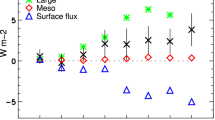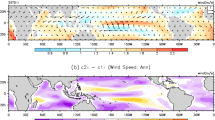Abstract
The surface heat and freshwater fluxes from equilibrium ocean (OGCM) and atmospheric (AGCM) general circulation model climates are examined in order to determine the minimum flux adjustment required to prevent climate drift upon coupling. This is accomplished by integrating an OGCM with specified surface fluxes. It is shown that a dramatic climate drift of the coupled system is inevitable unless ocean meridional heat and freshwater (salt) transports are used as constraints for tuning the AGCM present-day climatology. It is further shown that the magnitude of the mismatch between OGCM and AGCM fluxes is not as important for climate drift as the difference in OGCM and implied AGCM meridional heat and freshwater (salt) transports. Hence a minimum flux adjustment is proposed, which is zonally-uniform in each basin and of small magnitude compared to present flux adjustments. This minimum flux adjustment acts only to correct the AGCM implied oceanic meridional transports of heat and freshwater (salt). A slight extension is also proposed to overcome the drift in the surface waters when the minimum flux adjustment is used. Finally, it is suggested that the flux adjustments which arise from current methods used to determine them are all very similar, leading to adjustment fields which are significantly larger than both AGCM and climatological fields over large regions.
Similar content being viewed by others
References
Broecker WS (1987) The great ocean conveyor. Nat Hist Mag 97:74–82
Bryan K (1969) A numerical method for the study of the circulation of the world ocean. J Comp Phys 4:347–376
Bryan K, Manabe S, Pacanowski RC (1975) A global ocean-atmosphere climate model. Part II. The ocean circulation. J Phys Oceanogr 5:30–46
Cox MD (1984) A primitive equation, three-dimensional model of the ocean. GFDL Ocean Group Techn Rep 1
Cubasch U, Hasslemann K, Höck H, Maier-Reimer E, Mikolajewicz U, Santer BD, Sausen R (1992) Time-dependent greenhouse warming computation with a coupled atmosphere-ocean model. Clim Dyn 8:55–69
Cubasch U, Santer BD, Hellbach A, Hegerl G, Höck H, Maier-Reimer E, Mikolajewicz U, Stössel A, Voss R (1994) Monte Carlo climate change forecasts with a global coupled ocean-atmosphere model. Clim Dyn 10:1–19
da Silva AM, Young CC, Levitus S (1995) Atlas of surface marine data 1994, Vol 1: algorithms and procedures. NOAA Atlas NESDIS 7 (in press)
Fu R, Del Genio AD, Rossow WB, Liu WT (1992) Cirrus-cloud thermal sea surface temperatures tested using satellite data. Nature 358:394–397
Gates WL, Nelson AB (1975) A new (revised) tabulation of the Scripps topography on a 1° global grid. Part II: ocean depths, DARPA Rep
Gleckler PJ, Randall DA, Boer G, Colman R, Dix M, Galin V, Helfend M, Kiehl J, Kitoh A, Lau W, Liang X-Z, Lykossov V, McAvaney B, Miyakoda K, Planton S, Stern W (1995) Cloud-radiative effects on implied oceanic energy transports as simulated by atmospheric general circulation models. Geophys Res Lett 22:791–794
Haney RL (1971) Surface thermal boundary condition for ocean circulation models. J Phys Oceanogr 1:241–248
Hellerman S, Rosenstein M (1983) Normal monthly wind stress over the world ocean with error estimates. J Phys Oceanogr 13:1093–1104
Hughes TMC, Weaver AJ (1994) Multiple equilibria of an asymmetric two-basin ocean model. J Phys Oceanogr 24:619–637
Intergovernmental Panel on Climate Change (1992) Climate Change 1992. The Supplementary Report to the IPCC Scientific Assessment. Houghton IT, Callander BA, Varney SK (eds) Cambridge University Press, Cambridge
Intergovernmental Panel on Climate Change (1995) Climate Change. The IPCC Second Scientific Assessment (in press)
Lenderink G, Haarsma RJ (1994) Variability and multiple equilibria of the thermohaline circulation associated with deep water formation. J Phys Oceanogr 24:1480–1493
Levitus S (1982) Climatological atlas of the World Ocean. NOAA Prof Pap 13 US Department of Commerce: National Oceanic and Atmospheric Administration
McFarlane NA, Boer GJ, Blanchet J-P, Lazare M (1992) The Canadian Climate Centre second-generation general circulation model and its equilibrium climate. J Clim 5:1013–1044
Maier-Reimer E, Mikolajewicz U (1992) The Hamburg large scale geostrophic ocean general circulation model. Deutsches KlimaRechenZentrum Techn Rep 2, Hamburg
Manabe S, Stouffer RJ (1994) Multiple-century response of a coupled ocean-atmosphere model to an increase of atmospheric carbon dioxide. J Clim 7:5–23
Manabe S, Stouffer RJ, Spelman MJ, Bryan K (1991) Transient responses of a coupled ocean-atmosphere model to gradual changes of atmospheric CO2. Part I: annual mean response. J Clim 4:785–818
Manabe S, Spelman MJ, Stouffer RJ (1992) Transient responses of a coupled ocean-atmosphere model to gradual changes of atmospheric CO2. Part II: seasonal response. J Clim 5:105–126
Meehl GA, Washington WM, Karl TR (1993) Low-frequency variability and CO2. transient climate change. Part 1. Time-averaged differences. Clim Dyn 8:117–133
Murphy JM (1995) Transient response of the Hadley Centre coupled ocean-atmosphere model to increasing carbon dioxide. Part I: control climate and flux adjustment. J Clim 8:26–56
Murphy JM, Mitchell JFB (1995) Transient response of the Hadley Centre coupled ocean-atmosphere model to increasing carbon dioxide. Part II: spatial and temporal structure of response. J Clim 8:57–80
Pacanowski RC, Dixon KW, Rosati A (1991) The GFDL modular ocean model users guide. GFDL Ocean Group Techn Rep 2
Rahmstorf S (1994) Rapid climate transitions in a coupled ocean-atmosphere model. Nature 372:82–85
Ramanathan V, Collins W (1991) Thermodynamic regulation of ocean warming by cirrus clouds deduced from observations of the 1987 El Nino. Nature 351:27–32
Sausen R, Barthel K, Hasselmann K (1988) Coupled ocean-atmosphere models with flux correction. Clim Dyn 2:145–163
Semtner AJ (1986) Finite-difference formulation of a world ocean model. In: O'Brien JJ (ed) Advanced physical oceanographic numerical modelling, NATO ASI series, 186, Reidel, pp 187–202
UNESCO (1983) Algorithms for computation of fundamental properties of seawater. UNESCO technical papers in marine science, 44. UNESCO Division of Marine Sciences, France
Wallace JM (1992) Effect of deep convection on the regulation of tropical sea surface temperature. Nature 357:230–231
Washington WM, Meehl GA (1989) Climate sensitivity due to increased CO2: experiments with a coupled atmosphere and ocean general circulation model. Clim Dyn 4:1–38
Weaver AJ, Hughes TMC (1992) Stability and variability of the thermohaline circulation and its link to climate. Trends in Physical Oceanography, Research Trends Series, Council of Scientific Research Integration, Trivandrum, India, 1:15–70
Weaver AJ, Sarachik ES (1990) On the importance of vertical resolution in certain ocean general circulation models. J Phys Oceanogr 20:600–609
Weaver AJ, Marotzke J, Cummins PF, Sarachik ES (1993) Stability and variability of the thermohaline circulation. J Phys Oceanogr 23:39–60
Author information
Authors and Affiliations
Rights and permissions
About this article
Cite this article
Weaver, A.J., Hughes, T.M.C. On the incompatibility of ocean and atmosphere models and the need for flux adjustments. Climate Dynamics 12, 141–170 (1996). https://doi.org/10.1007/BF00211615
Received:
Accepted:
Issue Date:
DOI: https://doi.org/10.1007/BF00211615




